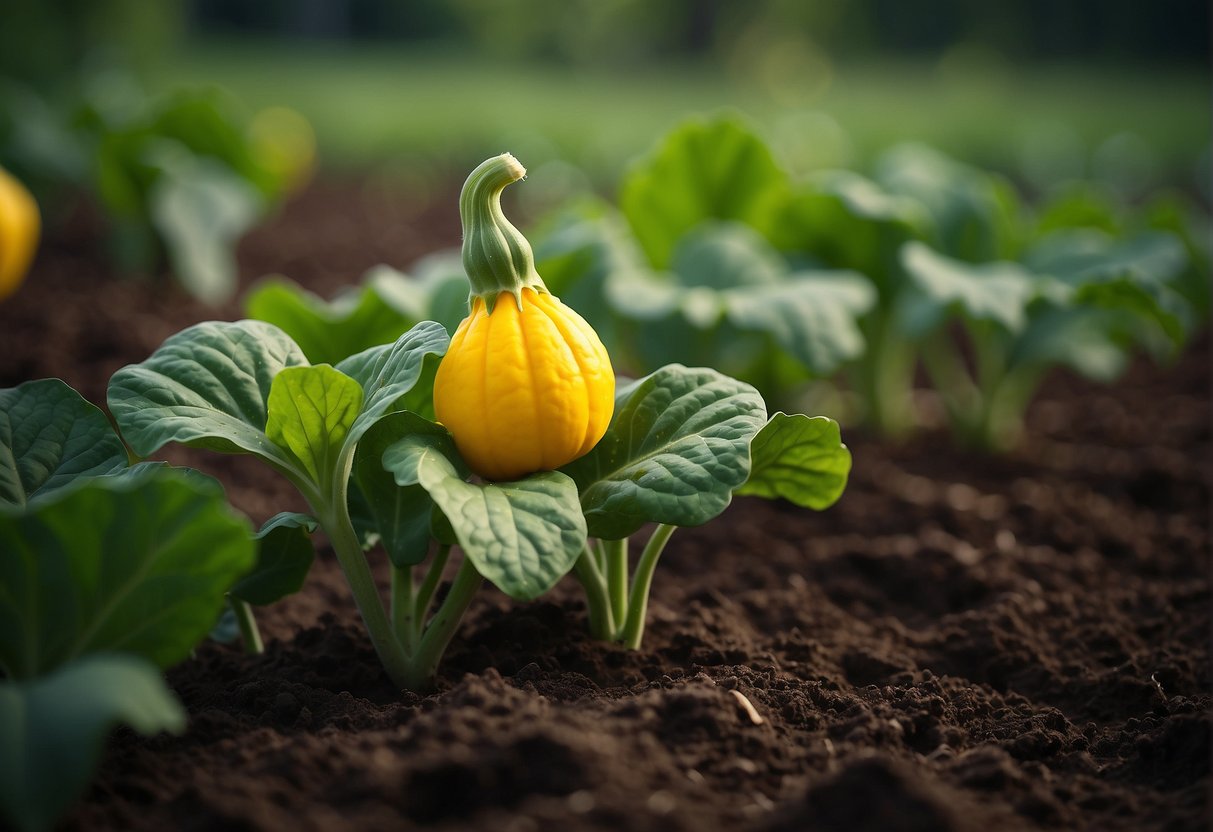Patty Pan Squash Plant: Growing Tips and Harvesting Techniques
Patty pan squash, also known as scallop squash or summer squash, is a type of squash that belongs to the species Cucurbita pepo. It is a small, round, and flat vegetable that comes in a variety of colors, including white, yellow, and green. Patty pan squash is easy to grow and is a popular choice for home gardeners.

One of the reasons why patty pan squash is so popular is its mild flavor. It has a slightly sweet taste and a tender texture, making it a versatile ingredient in many recipes. It can be roasted, grilled, sautéed, or used in soups and stews. Its unique shape also makes it a great choice for stuffing and baking.
Whether you are an experienced gardener or a beginner, patty pan squash is a great choice for your garden. It is easy to grow and produces a bountiful harvest throughout the summer months. With its mild flavor and versatile uses, it is a great addition to any kitchen.
Cultivation Essentials

Choosing the Right Location
When it comes to growing patty pan squash, choosing the right location is crucial. The plant requires full sun exposure, so it is essential to select a spot that receives direct sunlight for at least six hours a day. Additionally, it is essential to pick a location with well-draining soil, preferably sandy soil with a pH level of 6.0 to 6.8. Patty pan squash grows best in plant hardiness zones 3 through 10.
Soil Preparation and Planting
Before planting patty pan squash seeds, it is crucial to prepare the soil adequately. The soil should be enriched with compost or organic matter to improve its nutrient content. Additionally, it is essential to ensure that the soil temperature is at least 60°F before planting. Patty pan squash seeds should be planted 1 inch deep, and the plant should be spaced about 2 to 3 feet apart. It is best to plant the seeds after the last frost date.
Watering and Fertilization
Patty pan squash requires regular watering to thrive. It is essential to maintain soil moisture by watering the plant regularly, especially during dry spells. Additionally, the plant requires regular fertilization to ensure it receives the necessary nutrients. It is best to use a fertilizer high in potassium and magnesium to promote healthy growth.
Pest and Disease Management
Patty pan squash is susceptible to pests and diseases, such as aphids, beetles, root rot, yellowing leaves, wilting, and blossom end rot. To prevent these problems, it is essential to practice good pest control and disease management. This can be achieved by regularly inspecting the plant for signs of infestation or disease and taking appropriate action, such as using organic pesticides or removing infected plants. Mulching around the plant can also help to prevent soil-borne diseases.
Growth and Care
Patty pan squash plants are easy to grow and care for, making them a popular choice for home gardeners. Here are some tips for successfully growing and maintaining your patty pan squash plants.
Sunlight and Spacing Requirements
Patty pan squash plants require direct sunlight for at least 6 hours a day, so it’s important to choose a sunny spot in your garden. When planting seedlings, make sure to space them at least 18 inches apart to allow for proper growth and airflow. If you’re growing patty pan squash in pots, choose a large container that is at least 12 inches deep to allow for adequate root growth.
Maintenance Practices
To keep your patty pan squash plants healthy, it’s important to practice regular maintenance. This includes pruning any dead or damaged leaves, and removing any weeds that may be growing around the plants. Overwatering can be detrimental to patty pan squash plants, so make sure to water them only when the soil is dry to the touch. If you’re growing your plants in a trellis, make sure to tie them up regularly to prevent them from falling over.
Harvesting and Storage
Patty pan squash plants typically produce an abundant harvest during the summer months. When harvesting patty pan squash, it’s important to pick them when they are still small and tender, as larger squash can become tough and bitter. To store your harvest, keep the squash in a cool, dry place for up to a week. For longer storage, consider freezing or canning your patty pan squash.
By following these simple tips, you can enjoy a bountiful harvest of delicious patty pan squash all summer long.
Culinary Uses and Nutrition
Cooking and Preparation
Patty pan squash, also known as scallopini, sunburst, or peter pan, is a versatile vegetable that can be prepared in a variety of ways. Its mild flavor makes it a great addition to many dishes, and it can be roasted, fried, grilled, stuffed, sautéed, or added to pasta.
When cooking patty pan squash, it is important to note that it cooks quickly and can become mushy if overcooked. To avoid this, it is recommended to cook it quickly over high heat or to roast it in the oven until it is tender and slightly browned.
Health Benefits
Patty pan squash is not only delicious, but it is also packed with nutrients. It is a good source of vitamins A and C, as well as fiber and folate. It also contains minerals such as magnesium, potassium, and calcium.
Vitamin A is important for maintaining healthy vision and skin, while vitamin C is essential for a healthy immune system. Fiber helps to regulate digestion and can lower the risk of heart disease, while folate is important for fetal development during pregnancy.
Overall, patty pan squash is a nutritious and delicious addition to any meal. Whether roasted, sautéed, or stuffed, it is sure to add flavor and nutrition to any dish.
Frequently Asked Questions

How do you grow patty pan squash vertically?
Growing patty pan squash vertically is a great way to save space in your garden. You can use a trellis, stakes, or a fence to support the plants. To train the vines to grow vertically, gently tie them to the support structure with twine or plant ties. Be sure to provide enough support to prevent the vines from breaking under the weight of the fruit.
What is the ideal growing season for patty pan squash?
Patty pan squash is a warm-season crop that grows best in temperatures between 70°F and 95°F. It can be planted in the spring after the danger of frost has passed, or in late summer for a fall harvest. The plants require full sun and well-drained soil.
What is the recommended planting spacing for patty pan squash?
Patty pan squash plants should be spaced 24-36 inches apart, with rows 4-6 feet apart. This allows enough room for the plants to grow and produce fruit without overcrowding.
When is the right time to harvest patty pan squash?
Patty pan squash should be harvested when they are 2-3 inches in diameter. The fruit should be firm and have a bright, glossy skin. If the fruit is left on the plant too long, it can become tough and woody.
Is it necessary to use a trellis for patty pan squash plants?
While it is not necessary to use a trellis for patty pan squash plants, it can be helpful in saving space and preventing the fruit from touching the ground. A trellis can also make it easier to harvest the fruit and keep the vines organized.
Can you eat the skin of patty pan squash, and how do you prepare it?
Yes, you can eat the skin of patty pan squash. It is thin and tender, and does not need to be peeled. To prepare patty pan squash, simply wash it and cut off the stem and blossom ends. It can be sliced, diced, or roasted whole.


